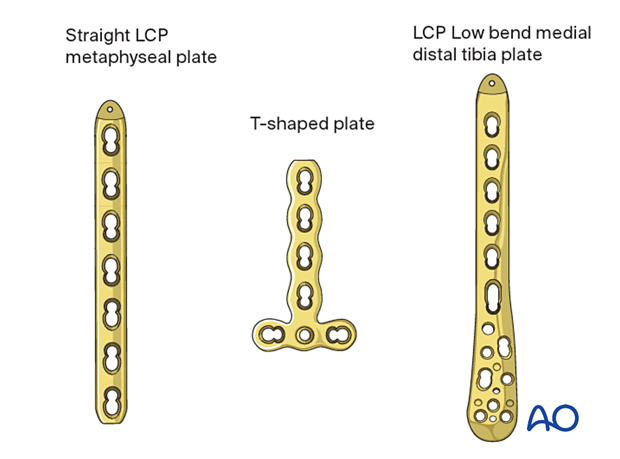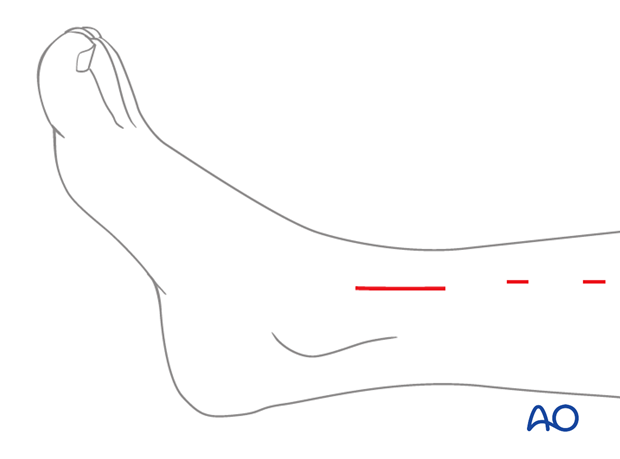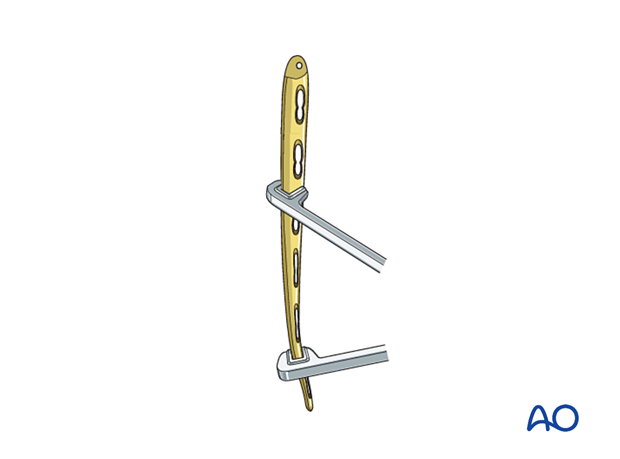MIO bridge plating
1. General considerations
Introduction
Metaphyseal multifragmentary fractures can be managed with medial plating and bridging of the comminuted portion of the fracture.
The aim is to correct ankle joint orientation, tibial length, and rotation.

In fractures with insufficient distal metaphyseal length, it may be necessary to bridge the physis.
The epiphyseal screw must be removed as soon as bone healing allows to prevent growth arrest and deformity.

Initial reduction and stabilization with external fixation
Consider external fixation as a preliminary treatment, especially when associated with a significant soft-tissue injury or open fractures.
Associated fibular fracture
A fibular fracture often reduces with reduction and fixation of the tibial fracture and does not require separate consideration.
If the alignment and stability of the fibular fracture are unsatisfactory after fixation of the tibial fracture, surgical treatment of the fibular fracture is also required.
If the distal tibial fracture is highly comminuted, fixation of the fibular fracture may add to overall stability.
Size and type of implant
2.0–4.5 mm plates are typically used in pediatric practice.
The age and weight of the patient, the anatomical site, and the load to which they will be subjected dictate the size of the implant.
Plates are available for use with locking and/or nonlocking screws and can be used for dynamic compression.
The plate should be long enough to insert at least two to three screws on each side of the fracture.
A straight plate can be used in more proximal metaphyseal fractures.
A T-shaped plate can be used in more distal metaphyseal fractures.
Adult anatomic plates for the distal tibia are contoured for periarticular placement. These may be appropriate for patients with a closing physis or, in rare cases, where stable fracture fixation requires bridging the physis. If they are used to manage fractures proximal to the physis, an angular deformity may result.

2. Preoperative planning
Preoperative planning is an essential part of the treatment of all distal tibial fractures because of the variability of the fracture pattern and patient characteristics.
This involves:
- Careful study of the x-rays
- Assessment of physis and growth remaining
- Definition of the fracture fragments and the desired result. This may be achieved with appropriate imaging software
- Choice of implants

3. Patient preparation and approach
Patient positioning
Place the patient in a supine position on a radiolucent table.

Approach
A minimally invasive medial approach to the distal tibia is used for this procedure.
Confirm the location of the physis with an image intensifier.

4. Reduction
Reduction of distal tibial and fibular fractures may be difficult. Support from at least one assistant, providing countertraction and stabilizing the proximal leg, may be helpful.
With the knee flexed and stabilized, apply longitudinal traction through the foot.
Correct translation and angulation of the fracture and confirm reduction clinically and with an image intensifier if available.

Reduction aids
The gastrocnemius muscle can be relaxed by flexing the knee and the ankle.
Reduction can be performed with:
- Pointed reduction forceps
- A Hohmann retractor, used as a lever to correct translation
- K-wires, used as a joystick to control the distal fragment
Reduction may be achieved and maintained with a distractor or temporary external fixator.

5. Plate contouring
If locking screws are used, the plate will not be compressed to the bone and does not need to be anatomically contoured.
If a straight plate is used, the distal end should be contoured to match the internal torsion of the distal tibia.

6. Plate fixation
Plate insertion
Apply the plate using a minimally invasive technique.
The plate is usually positioned on the anteromedial aspect of the tibia unless this is prevented by the fracture configuration.
Create a submuscular tunnel using the plate or a blunt dissector.

Use a percutaneous approach to stabilize the plate with a temporary K-wire inserted through the proximal pilot hole.
Insert a second K-wire through the distal pilot hole and confirm plate alignment with an image intensifier.

Use the same percutaneous incision to insert he most proximal screw.

Screw insertion
The periosteum and perichondral ring should not be disturbed.
To protect the perichondral ring, a dissector or elevator may be used to offset the plate during screw insertion.
If an anatomical plate is selected, locking screws should be used adjacent to the physis to prevent compression of the perichondral ring.
Insert the screws into the distal fragment and complete proximal screw insertion.
The dissector or elevator is removed after screw fixation.

Check the final construct with an image intensifier.

7. Fibular fracture management
Most fibular fractures do not require treatment. Indications for fixation include:
- Augmentation of the stability of tibial fracture fixation
- Significant displacement of the fibular fracture
The type of fracture pattern dictates the method of fixation of the fibular fracture.
In a younger child, these fractures may be fixed with K-wires in a standard manner. Multiple passes of the K-wire through the physis should be avoided.
In an older patient with a closing physis, these fractures may require plate fixation.
If screws are inserted on both sides of the physis, compression should be avoided and the periosteum and perichondral ring not be disturbed. To protect the perichondral ring, a dissector or elevator may be used to offset the plate during screw insertion. The plate should be removed soon after the fracture has healed.

8. Final assessment
Recheck the fracture alignment and implant position clinically and with an image intensifier before anesthesia is reversed.
Confirm stability of the fixation by moving the ankle through a range of dorsi/plantar flexion.
9. Immobilization
A molded below-knee cast or fixed ankle boot is recommended for a period of 2–6 weeks as the strength of fixation may not provide sufficient stability for unrestricted weight-bearing.

10. Aftercare
Immediate postoperative care
Weight-bearing is encouraged.
Older children may be able to use crutches or a walker.
Younger children may require a period of bed rest followed by mobilization in a wheelchair.
Pain control
Patients tend to be more comfortable if the limb is splinted.
Routine pain medication is prescribed for 3–5 days after surgery.
Neurovascular examination
The patient should be examined frequently to exclude neurovascular compromise or evolving compartment syndrome.
Discharge care
Discharge follows local practice and is usually possible within 48 hours.
Follow-up
The first clinical and radiological follow-up is usually undertaken 5–7 days after surgery to check the wound and confirm that reduction has been maintained.
Cast removal
A cast or boot can be removed 2–6 weeks after injury.
Mobilization
After cast removal, graduated weight-bearing is usually possible.
Patients are encouraged to start range-of-motion exercises. Physiotherapy supervision may be required in some cases but is not mandatory.
Sports and activities that involve running and jumping are not recommended until full recovery of local symptoms.

Implant removal
Implant removal is not mandatory and requires a risk-benefit discussion with patient and carers.













